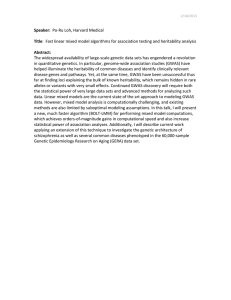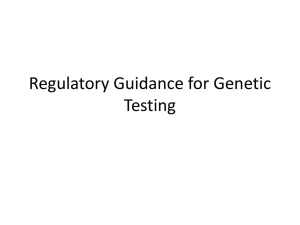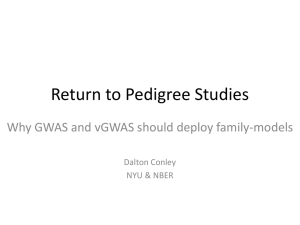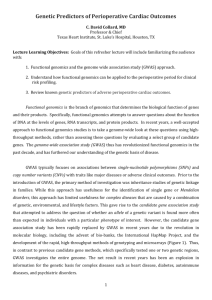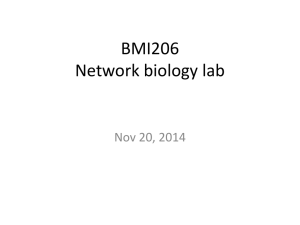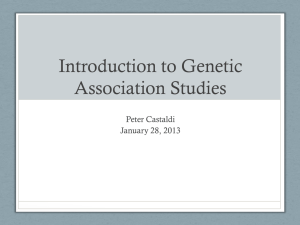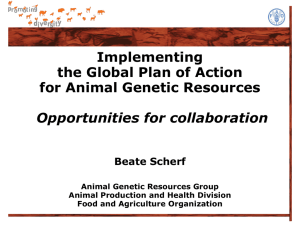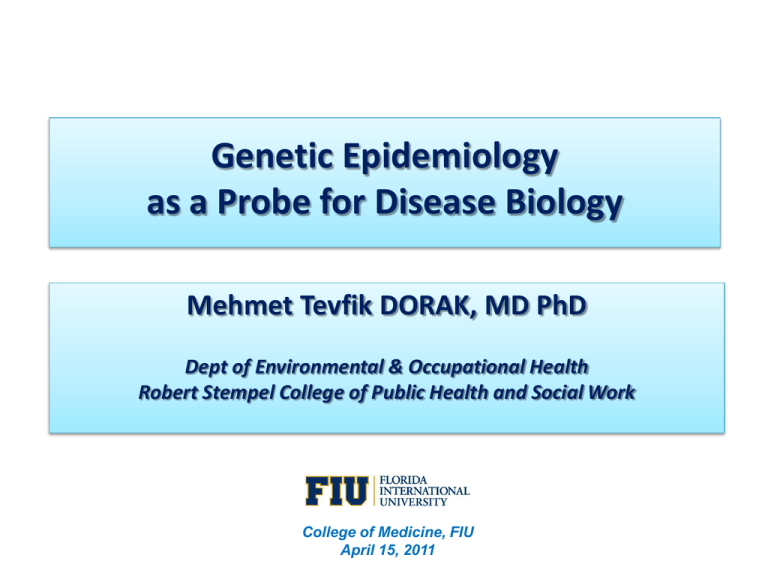
Genetic Epidemiology
as a Probe for Disease Biology
Mehmet Tevfik DORAK, MD PhD
Dept of Environmental & Occupational Health
Robert Stempel College of Public Health and Social Work
College of Medicine, FIU
April 15, 2011
OUTLINE
General introduction to epidemiology, genetic
epidemiology and genetic association studies
Success stories leading to ?
Real power of genetic association studies
Conclusions
PLoS Med. 2005 Aug;2(8):e124.
WSJ. 2004Sep14.
Case-control genetic association studies
are more common than cohort studies or
linkage studies
Why?
- They are cheaper
- They are easier
- They are quick
- They are easier to analyze
Of course, genetic association studies are
performed to find the causal genetic
polymorphisms and to learn more about
disease biology.
- They are cheaper
- They are easier
- They are quick
- They are easier to analyze
However, these advantages have been
exploited by many in need of a quick
publication!
Hierarchy of Epidemiologic Study Design
Tower & Spector, 2007
(www)
When used for scientific enquiries,
however, genetic association studies yield
very informative results
Following is a brief history of genetic
epidemiology and examples of good use of
genetic association studies
GENETIC EPIDEMIOLOGIC RESEARCH METHODS
Handbook of Statistical Genetics
(John Wiley & Sons)
Fig.28-1 (www)
Odds Ratio: 3.6
95% CI = 1.3 to 10.4
ROCHE Genetic Education (www)
Mapping Disease Susceptibility Genes by Association Studies
Plot of minus log of P value for case-control test for allelic association with AD, for SNPs immediately
surrounding APOE (<100 kb)
Martin, 2000 (www)
Mapping Disease Susceptibility Genes by Association Studies
(www)
culprit?
GWAS Success Stories
GWAS Success Stories
The most robust association in GWAS to date
rs380390
GWAS Success Stories
The most robust association in GWAS to date
rs380390 >>> Y402H
OR = 7.4 (r)
96 cases & 50 controls
• Chromosomal region 1q31 where CFH maps had been identified as a
candidate region in six linkage studies
• Activated C5b-9 complex has been detected in patients with AMD
• Complement factor H levels increase with age and in smokers; two
risk factors for AMD
• Complement factor H is detectable in the eye
GWAS Success Stories
GWAS Success Stories
GWAS Success Stories
GWAS Success Stories
GWAS Success Stories
GWAS Success Stories ?
(www)
(www)
It is therefore unlikely that as we perform them now
even GWAS do not have sufficient power to decode
the substantial portion of genetic component in
disease susceptibility.
(www)
Genetic Association Studies are Particularly Powerful:
- To test whether reverse causation is involved
(iron deficiency in GI tract cancers; low cholesterol in cancer)
- To unravel effect modification (by gender or an environmental
factor)
Genetic association results are cumulative results determined by
the whole body and environment unlike results of in vitro
experiments on a single cell under extremely controlled
environments
In a case-control study:
• Cause and effect relationship is not clear
• The observed association may be caused by a confounder
• It may be due to chance
• Reverse causation cannot be ruled out
Mendelian randomization may be relied on when the confounder
is suspected but not known
Randomization is naturally achieved in genetic association
studies
Cause-and-Effect Relationship is Easier to Assess
in Genetic Association Studies
Grimes & Schulz, 2002 (www) (PDF)
Effect Modification by an Environmental Factor
(www)
iron
levels
Iron Regulatory Gene Variants and
Modification of Cancer Risk
High cancer risk
wt
variant
low iron levels
protection
High cancer risk
wt
Low iron
environment
variant
high iron levels
High iron
environment
risk
Mendelian Randomization
Effect Modification by Gender
Despite that males and females are
almost different species, the gender
effect is almost always disregarded in the
analysis of biomedical research results
Inflammatory Bowel Disease
• IBD3 maps to chromosome 6p in linkage studies and known as
the HLA-linked IBD susceptibility locus
Effect Modification by Gender
HLA-DRB4 Association in Childhood ALL
40
25
%
%
*
Patients
30
Controls
Boys, n=64
Patients
20
15
Controls
Girls, n=53
20
10
*
10
5
0
0
DRB5
DRB3
DRB4
DRB5
DRB3
DRB4
Homozygosity for HLA-DRB4 family is associated with susceptibility to childhood ALL
in boys only (P < 0.0001, OR = 6.1, 95% CI = 2.9 to 12.6 )
Controls are an unselected group of local newborns (201 boys & 214 girls)
* Case-only analysis P = 0.002 (OR = 5.6; 95% CI = 1.8 to 17.6)
Effect Modification by Gender
rs5755709 G>A
rs2071746 A>T
STR
-10kb
HMOX1 5’ flanking region
2
2
2
P = 0.03
1
1
0
0
AA
AB
BB
P = 0.21
0.2
AA
0.4
AB
0.6
BB
OR
OR
OR
P = 0.51
0
-416
1
0
0
0.8
0.2
AA
0.4
AB
0.6
BB
P (sex) = 0.015
P (sex; case-only) = 0.01
Effect Modification by Gender
NRAMP2 rs422982 shows sex-specific associations in childhood leukemia
CONCLUSIONS
Observational epidemiologic studies are useful to
explore disease biology and generate hypotheses
when used appropriately
Identification of the whole of genetic component of
disease susceptibility requires more than DNA
sequence analysis
Dorak Lab is open for business!
ACKNOWLEDGMENTS
Anyone who has ever taught me anything
My current team
Malar, Amy and Sandeep
Florida International University
RSCPHSW
EOH

